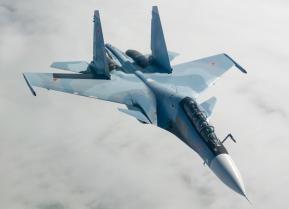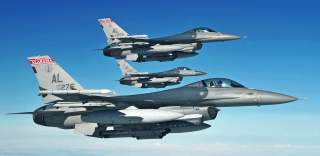The U.S. Military's Ships, Tanks, Aircraft and Drones Are Getting AI
And that is a really big deal.
The Pentagon is making a massive push to accelerate the application of artificial intelligence to ships, tanks, aircraft, drones, weapons and large networks as part of a sweeping strategy to more quickly harness and integrate the latest innovations.
Many forms of AI are already well-underway with US military combat systems, yet new technologies and applications are emerging so quickly that Deputy Secretary of Defense Patrick Shanahan has directed the immediate creation of a new Joint Artificial Intelligence Center.
“The Deputy Secretary of Defense directed the DoD Chief Information Officer to standup the Joint Artificial Intelligence Center in order to enable teams across DoD to swiftly deliver new AI-enabled capabilities and effectively experiment with new operating concepts in support of DoD's military missions and business functions." DoD spokeswoman Heather Babb told Warrior Maven.
Pentagon officials intend for the new effort to connect otherwise disparate AI developments across the services. The key concept, naturally, is to capitalize upon the newest and most efficient kinds of autonomy, automation and specific ways in which AI can develop for the long term -- yet also have an immediate impact upon current military operations.
Recommended: Air War: Stealth F-22 Raptor vs. F-14 Tomcat (That Iran Still Flies)
Recommended: A New Report Reveals Why There Won't Be Any 'New' F-22 Raptors
Recommended: How an ‘Old’ F-15 Might Kill Russia’s New Stealth Fighter
AI performs a wide range of functions not purely restricted to conventional notions of IT or cyberspace; computer algorithms are increasingly able to almost instantaneously access vast pools of data, compare and organize information and perform automated procedural and analytical functions for human decision-makers in a role of command and control. While AI can of course massively expedite data consolidation, cloud migration and various kinds much-needed cybersecurity functions, it is increasingly being applied more broadly across weapons systems, large platforms and combat networks as well.
Rapid data-base access, organizing information and performing high-volume procedural functions are all decided advantages of AI applications. Algorithms, for example, are increasingly able to scan, view and organize ISR input such as images or video – to identify points of combat relevance of potential interest to a commander.
AI enabled technology can perform these kinds of procedural functions exponentially faster than humans can, massively shortening the crucial decision-making timeframe for combat decision makers. At the same time, many experts, developers and military leaders recognize that the certain problem-solving faculties and subjective determinations unique to human cognition - are still indispensable to decision making in war.
For this reason, advanced AI relies upon what developers refer to as “human-machine” interface or “easing the cognitive burden” wherein humans function in a command and control capacity while computer automation rapidly performs a range of key procedural functions.
AI & IT
This AI-driven phenomenon is of particular relevance when it comes to data systems, IT as a whole and advances in cybersecurity. For instance, Air Force developers are using advanced computer automation to replicate human behavior online – for the specific purpose of luring and tracking potential intruders. Also, AI can be used to perform real-time analytics on incoming traffic potentially containing malware, viruses or any kind of attempted intrusion. If the source, characteristics or discernable pattern of an attempted intrusion are identified quickly, cyber defenders are better positioned to respond.
When high-volume, redundant tasks are performed through computer automation, humans are freed up to expend energy pursuing a wider range of interpretive or conceptual work.
For example, the Army is working with a private firm called NCI to establish a certification of worthiness for a specific AI-enabled program designed to streamline a number of key tasks.
The NCI-developed program enables account creation, account deletion, background checks and other kind of high-volume data analysis.
“You can log into 10 different websites simultaneously, rather than having a person do that. A machine can go through and gather all the information for a person,” Brad Mascho Chief AI Officer, NCI, told Warrior Maven in an interview. “Humans can focus on higher priority threats.”
At the same time, big data analytics can quickly present new challenges for a variety of key reasons; a larger data flow can make it difficult for servers to “flex” as needed to accommodate rapid jumps in data coming through. Therefore, AI-empowered algorithms such as those engineered by NCI are needed to organize incoming data and identify anomalies or potential intrusions.
There is also a growing need for more real-time monitoring of activity on a message “bus,” because standard analytics methods based on probability and statistical probability often detect intrusions after the fact and are not always reliable or 100-percent accurate, cybersecurity experts and analysts explain.
AI & Navy Ships
The Navy is taking technical steps to expand AI and cyber harden its growing ship-based ocean combat network, called Consolidated Afloat Networks and Enterprise Services (CANES).
CANES is being installed on carriers, amphibious assault ships, destroyers and submarines, and the service has completed at least 50 CANES systems and has more in production, Navy developers said.
Upgraded CANES, which relies upon hardened cyber and IT connectivity along with radio and other communications technologies, is being specifically configured to increase automation - and perform more and more analytical functions without needing human intervention. It is one of many emerging technologies now being heavily fortified by new algorithms enabling artificial intelligence, senior Navy leaders told Warrior Maven.
Surface ships such as the Littoral Combat Ship, rely upon a host of interwoven technologies intended to share key data in real time - such as threat and targeting information, radar signal processing and fire control systems. CANES connectivity, and AI-informed analysis, can be fundamental to the operation of these systems, which often rely upon fast interpretation of sensor, targeting or ISR data to inform potentially lethal decisions.
The LCS, in particular, draws upon interconnected surface and anti-submarine “mission packages” engineered to use a host of ship systems in coordination with one another. These include ship-mounted guns and missiles along with helicopters, drones such as the Fire Scout and various sonar systems - the kinds of things potentially enhanced by AI analysis.
Navy developers say increasing cybersecurity, mission scope and overall resiliency on the CANES networks depends on using a common engineering approach with routers, satcom networks, servers and computing functions.
Increased computer automation also performs a large function on the Navy’s emerging Ford-Class aircraft carriers. The new carriers use advanced algorithms to perform diagnostics and other on-board maintenance and procedural tasks independently. This, Navy developers say, allows the service to reduce its crew size by as many as 900 sailors per carrier and save up to $4 billion dollars over the life of a ship.
AI & Cyber Defense
Algorithms calling upon advanced AI are being used to quickly access vast pools of data to perform real-time analytics designed to detect patterns and anomalies associated with malware.
“Every day, the Defense Department thwarts an estimated 36 million e-mails containing malware, viruses and phishing schemes from hackers, terrorists and foreign adversaries trying to gain unauthorized access to military systems,” Babb told Warrior Maven earlier this year.
One particular technique, now being developed by CISCO systems, seeks to address a particular irony or cybersecurity paradox; namely, while much DoD network traffic is encrypted for additional safety, encryption can also make it more difficult for cyber defenders to see hidden malware in the traffic.
CISCO is now prototyping new detection methods as part of an effort to introduce their technology to the US military services.
“We have the ability to read and detect malware in encrypted web traffic. Even though the data is encrypted there is still a pattern to malware,” Kelly Jones, Systems Engineer for CISCO Navy programs, told Warrior Maven.
AI & Large Combat Platforms, Tanks & Fighter Jets
Real-time analytics, informed by AI, has already had much success with both Army and Air Force Conditioned-Based Maintenance initiatives. The Army used IBMs Watson computer to perform real-time analytics on sensor information from Stryker vehicles and tactical trucks.
Drawing upon seemingly limitless databases of historical data, Watson was able to analyze information related to potential engine failures and other key vehicular systems. Properly identifying when a given combat-vehicle system might malfunction or need repairs helps both combat and logistical operations. Furthermore, the Army-IBM Stryker “proof of principle” exercise was able to wirelessly transmit sensor data, enabling AI to compare new information gathered against a historical database in seconds.
The Army is also working with IBM to test AI-enabled “autonomy kits” on tactical trucks designed to enable much greater degrees of autonomous navigation.
Advanced computer algorithms, enhanced in some instances through machine learning, enable systems such as Watson to instantly draw upon vast volumes of historical data as a way to expedite analysis of key mechanical indicators. Real-time analytics, drawing upon documented pools of established data through computer automation, can integrate otherwise disconnected sensors and other on-board vehicle systems.
“We identified some of the challenges in how you harmonize sensor data that is delivered from different solutions. Kevin Aven, partner and co-account lead, Army and Marine Corps, IBM Global Business Services, told Warrior Maven in an interview earlier this year.


